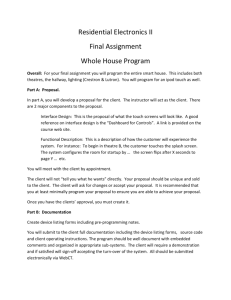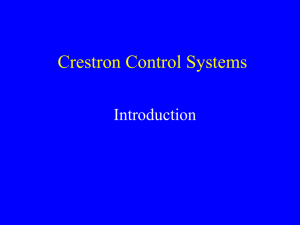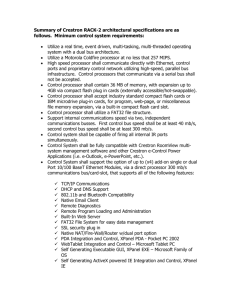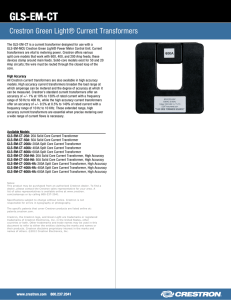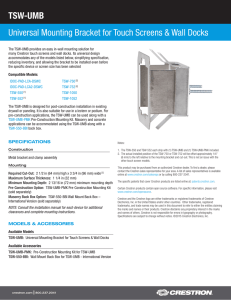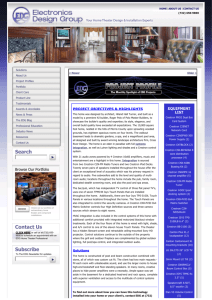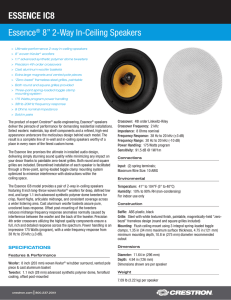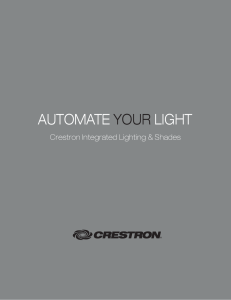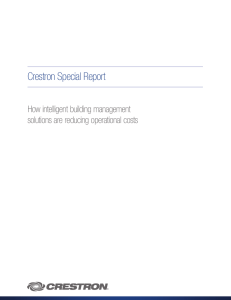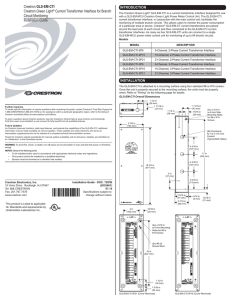What is Energy Monitoring?
advertisement
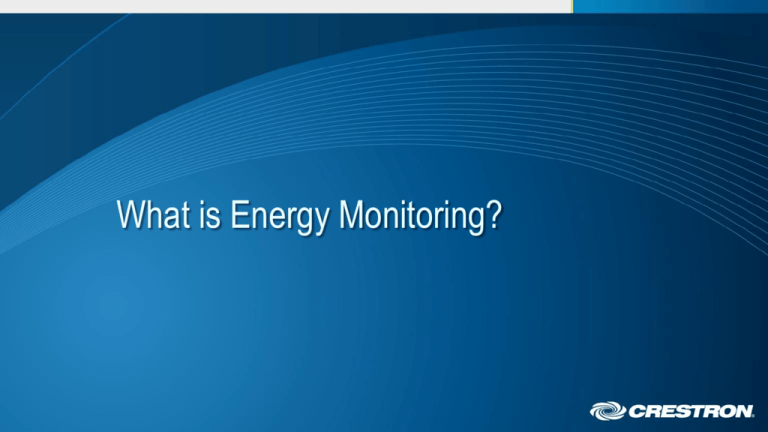
What is Energy Monitoring? Market Direction • The lighting control industry being driven to manage energy holistically and to show ROI – – – – Energy costs are going to go up Changing regulations are impacting local building codes Clean energy is expensive and unreliable for the supply side Being green is not just a marketing strategy, it’s a necessity to be efficient and reduce operating expenses What do you need? • Products that can actually help lower operating costs • Products help owners and facility managers prove that they’re doing the right thing • Transition from simply monitoring energy usage to management of energy Energy Monitoring • Hardware and software that connects to your energy resources to provide a defined baseline of energy consumption • Knowing is the start – you need to see what your energy usage is as a starting point Energy Monitoring Technologies Calculated - Good • If we know that a load is 50W and it’s at 50%, can’t we just assume it’s using 25W? – Not really… – We can get fairly close with load profiling, but the wattage numbers don’t scale linearly – Commercially, ballasts are very difficult to accurately profile – The numbers produced by these guesses can be off by 20% • Really only works for lighting, not all loads Current Monitoring - Better • Assume that the voltage is stable and measure the actual current – P=I*V – Can provide fairly accurate results for stable voltages – Has a problem with active loads, like ballasts • Power factor correction helps in the “on” state • “Off” state will read much higher than actual power due to phase shifts – Can expect a 10% error in measurements • Can be used for non-lighting loads Power Metering - Best • Samples real voltage and real current at high frequencies • Compensates for phase offsets • Doesn’t get fooled by voltage drops or non-linear current scaling • Expensive • Errors can be smaller than 1% • Useful for measuring ANY electrical load Crestron Solution • Whatever your level of energy sustainability, we can help make an impact • We have calculated, current monitoring and power metering solutions to help you grow and evolve your level of energy management Crestron Calculated Solutions • Supported by every Crestron processor • No special products required – Lowest hardware cost – Great initial solution for starter retrofit applications • Works perfectly with Crestron’s range of wired and wireless dimmers and switches, including 120/240/277V Crestron Current Monitoring • Crestron products include optional “PM” version to deliver current monitoring data – Green Light® Power Pack – Green Light® Integrated Lighting System – Green Light® DALI Ballasts Crestron Energy Monitoring Solution GLS-EM-MCU: Metering Control Unit • • Ethernet based • • Main Panel Feed Monitoring • and/or Branch Monitoring • • • • Power metering across 3 phases (main legs) Reports data to control system and Fusion EM Monitors & logs Voltage, Current, & Active Power Monitors up to 84 individual branch circuits (With GLS-EM-CTI) Installs next to an electrical panel Operable with 100-347V, split and 3 phase systems Non-volatile memory reliability stores internally logged data GLS-EM-MCU – Parts and Pieces • GLS-EM-MCU: Mains monitor • GLS-EM-CTI-*: Branch monitors • GLS-CT-*: Current transformers – These come in standard and high accuracy models – HA might allow us to claim revenue grade metering GLS-EM-MCU • • • • Main monitor Need one per panel Monitors three main feeds and four pulse inputs Can support four branch monitors – Up to 84 branches • 100-347VAC (Yes, 347!) GLS-EM-CTI • Branch monitors – Comes in 6, 15 and 21 branch options – Specific for two and three phase systems • Connects to the GLS-EM-MCU via a 7-wire bus – Also has a pass-through for next GLS-EM-CTI unit • Reports through the GLS-EM-MCU GLS-CT • Current transformers – every monitored leg needs one • Comes in multiple varieties: – – – – – – 20A 50A 200A 400A 600A High Accuracy/Standard Accuracy • High accuracy version has factory calibration to remove small errors due to manufacturing differences – Improves error from 5% to <1% (May allow us to claim revenue grade – still investigating) Available Information • Real Time Information - Power – Voltage – Active Power – Pulse Rate • Historical Information – Energy – – – – – – – – Voltage Current Active Power Energy Pulse Usage Power Factor Energy Meter (aggregated) Pule Meter (aggregated) Pulse Metering • Allows for inclusion of 3rd party metering devices • Keeps precise count of pulse rate and pulse count • Typically used for water or natural gas Odds and Ends • Often, for larger buildings, the main feed is much larger than 600A. How does this get monitored? – For these large installations the feed is typically broken up into multiple, parallel, 600A (or less) feeds – Our tools allow us to clamp one CT onto one parallel feed and instruct the monitor to compensate for the fact that multiple feeds are in use (Basic multiplication) Energy Monitoring Technologies - Recap • Three monitoring technologies – Guessed/Estimated • Supported by all Crestron products • Not as accurate – Current Measurement Only • Supported by Crestron PM option products • Mid-level accuracy – Power Measurement • Measured by a dedicated device: GLS-EM-MCU • Most accurate option for measurement Bringing It All Together • All of these work well independently • The real power is harnessed when you bring these technologies together into a overarching energy management strategy The Next Step… Energy Management Making the Transition from Monitoring to Management • Using the data gathered from the energy monitoring hardware and software, the facility manager realizes there’s an opportunity for savings • Now that there are metrics, the goal is to make the numbers move – We do this via our control products and Fusion™ What are the steps involved? • Metering your energy consumption and collecting the data by using an energy monitoring software • Uncover places to save energy - such as making upgrades or replacing inefficient equipment • Putting into place energy saving functions – such as demand response settings or eliminating wasted energy in unoccupied spaces • Tracking progress by analyzing the real-time data and comparing with historical information to what these efforts are actually achieving Crestron Energy Management 6-Part Panel-Based Energy Management System: 1. Electrical Panel 2. Current Transformers (GLS-EM-CT) 3. Current Transformer Interface (GLS-EM-CTI) 4. Meter Control Unit (GLS-EM-MCU) Control Processor (MC3) 5. 6. Analysis Software (Fusion) Crestron Building Management System Gateway • Seamless integration of lighting, shades, HVAC, security, IT, and AV with existing building management systems and other devices – no other gateway needed • Direct connection over BACnet/IP through Crestron 3 Series Control Processors • Works with BACnet/IP, LonWorks, Modbus, KNX and others Bringing it all together: Monitor, Manage AND Control The Crestron solution for the management of information and resources within the building to reduce energy consumption, save time and money is Fusion EM™ Fusion EM is the tool that allows you to Monitor, Manage and Control your entire operation Bringing it all together: Monitor, Manage AND Control Monitor: See all energy resources including data analysis from your energy monitoring devices. Compare historical vs. real-time energy usage Manage: Use the software to implement change and automate functions and schedule events such as: – Temperature and lighting level set points – Demand response settings – Global lighting and climate control for unoccupied spaces Control: Anticipate needs based on the occupants and usage. By using Fusion for predictive management of the facility you can ensure they are being utilized efficiently Thank you! Want more information? Call us at 855.263.8454 or visit crestron.com
